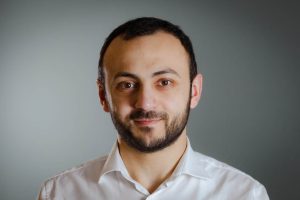Rustam Guliev is an Azerbaijanian from Moscow, Russia. He is 32 years old. His journey began with a Specialist degree in Applied Mathematics and Computer Science at Lomonosov Moscow State University. During that time, he delved into the intriguing world of mathematical modeling, particularly in the context of cancer treatment. His thesis project involved applying the dynamic programming approach to a system of differential equations to model cancer treatment outcomes, allowing for the estimation and identification of the most optimal treatment strategies. Alongside his academic achievements, he honed his programming skills in various languages, including MatLab, C\C++, SQL, and more.

Figure 1: Rustam Guliev
Following the completion of the Specialist program, his career path ventured into the industry, where he joined GlowByte Consulting as an ETL/DWH Developer. There he played a pivotal role in optimizing high-load export processes, mentored new developers, and collaborated with the team to meet project deadlines effectively. His programming proficiency extended to SAS, bash, and unix systems. This experience significantly improved his personal efficiency, teamwork, task management, and Scrum skills.
However, later his preference was given to academia where he had an impactful journey at the Emanuel Institute of Biochemical Physics, Russian Academy of Sciences. First, he started as a Postgraduate student focused on developing a predictive model to estimate the risk of postdischarge outcomes for patients with Acute Coronary Syndrome; and later embraced the role of a Research Fellow specializing in the application of chemometrics and data analysis in fields of microbiology and biomedicine. During this phase, he achieved significant milestones, authoring articles in reputable journals, contributing to open-source projects, automating data processing, and analyzing data of various types. As an initiative-driven individual, he built a cloud-based system for data collection, storage, and export, which continues to be utilized by his former colleagues to this day.
Later in his academic career, he embarked on a new chapter by joining the IMAGE-IN project as a PhD Researcher at Leibniz-Institut für Photonische Technologien e.V. in Jena, Germany. He continues to work there passionately, and as part of the program, he is currently undertaking a secondment at BMD.
About the research
Rustam’s research revolves around analyzing host-pathogen interactions using Raman spectroscopy. Specifically, he specializes in hyperspectral unmixing techniques and their application to Raman hyperspectral images. His work has made significant contributions to open-source projects like unmixR and pyspc-unmix (R and Python packages for hyperspectral data unmixing).
Through his research, Rustam has published valuable findings, including in papers like “Label-Free Characterization of Macrophage Polarization Using Raman Spectroscopy”, where he successfully applied hyperspectral unmixing and data analysis algorithms to distinguish different phenotypes of macrophages. For instance, the difference in lipids concentration was demonstrated using fraction concentrations estimated by N-FINDR unmixing algorithm. In another study, titled “Insights into S. aureus-Induced Bone Deformation in a Mouse Model of Chronic Osteomyelitis Using Fluorescence and Raman Imaging” he applied a similar analysis to hyperspectral Raman images of mice bone to characterize infected mouse bone and identify the pathogen’s location. Additionally, in “High-throughput Raman spectroscopy allows ex vivo characterization of murine small intestinal intra-epithelial lymphocytes (IEL)” Rustam analyzed data acquired by an advanced high-throughput Raman technique. A thorough data analysis allowed the detection of differences in cells originating from two groups of animals: intestinal inflammation (received T cells) and untreated (control). Applying MCR-ALS unmixing strategy allowed to characterize cell clusters found in the data as well as the difference between the two groups.
Internship
As Rustam delved deeper into his studies, his focus started shifting towards exploring the potential of the application of cloud and deep learning technologies to Raman spectroscopy data. Recognizing the expertise that BMD possessed in these areas, we saw an opportunity to collaborate and provide guidance to further enhance his research. The collaboration with our experts in the corresponding fields already opened new avenues for his research, allowing to gain deeper insights from industrial state-of-the-art technologies.
We are eager to see the transformative impact this collaboration will have on Rustam’s academic pursuits. With a shared passion, we are confident that his time at BMD will be an enriching chapter in his academic and professional journey.
